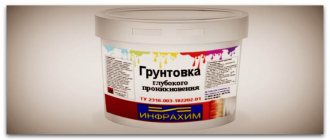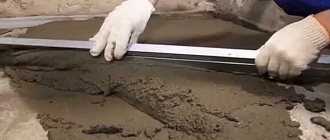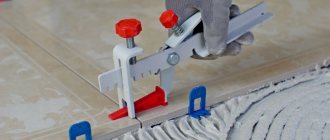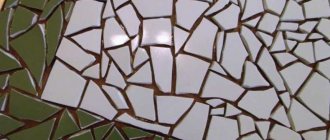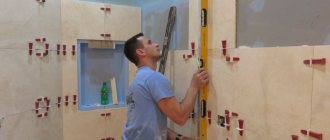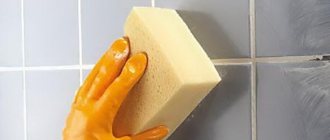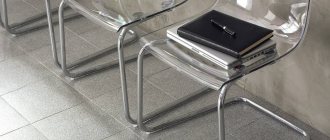When choosing ceramic tiles, it is not enough just to focus on their appearance. It is important to pay attention to its dimensions and thickness.
The thickness of ceramic tiles is an important indicator that determines where they can be laid - on the floor or wall. In this article we invite you to consider all these indicators in detail.
Classic ceramic tile format
Throughout the 20th century, in many apartments and houses one could see the decoration of utility rooms, including the kitchen and bathroom, with white ceramic tiles and standard sizes of 10X10 and 15X15 cm.
- The usual size of tiles is considered classic and the most universal, as it is suitable for structures of various purposes and sizes.
- On a surface covered with ordinary tiles of average parameters, an acceptable number of seams is created, with the least waste.
- It is especially in demand for finishing architectural structures of complex geometric shapes.
When laying medium ceramic tiles, wedges are used instead of plastic crosses, which helps to more accurately form the distances between the piece finishing material.
Advantages and disadvantages
The popularity of ceramic tiles is due to the fact that they:
- environmentally friendly - it consists of natural ingredients that are absolutely safe for humans. The material is made from several types of clay and sand;
- durable - tile is several times superior to concrete in its ability to withstand heavy loads. It obtains such properties as a result of hot pressing and firing;
- resistant to moisture – has a dense waterproof coating, so it does not absorb water, grease, detergents, odors, and prevents the formation of fungus;
- resistant to scratches, abrasions and other minor damage due to the technology of calcination and formation of the surface layer;
- resistant to sunlight - the color of the background, patterns and ornaments does not change over time - does not fade;
- fire resistant - does not support combustion and does not melt;
- practical - ceramic coating is not afraid of exposure to cleaning agents;
- Suitable for any interior - tiles are available in a huge variety of colors and textures.
Weaknesses of the material:
- high thermal conductivity - the surface of the tile is always cold. Walking on it barefoot is unpleasant and dangerous to health. However, the “warm floor” system will easily solve this problem;
- fragility - tiles should be transported and handled very carefully, as they are easy to split. Heavy and sharp objects falling on tiles can cause irreparable damage;
- insufficient sound insulation - additional protection is required in the form of a layer of sound-proofing material, which leads to an increase in the cost of the process;
- slippery surface - moving on tiles with a glazed coating is very difficult, especially if it is wet. Therefore, for the bathroom you should prefer products with a rough surface.
When choosing a material for repair, consider all the positive and negative aspects of the material. This will help you choose the best option for you.
Large format ceramic tiles
Until recently, large ceramic tiles were used to cover large areas of industrial buildings or retail spaces. But recently, large-format tiles have been actively used in the interior design of residential buildings and spacious apartments.
Sometimes it can be seen among the external decoration elements of various buildings. Large tiles include ceramic products with one side measuring from 50 to 120 cm. Most often on sale you can find large tiles with perimeters of 60X90, 90X90, 60X120 cm.
A relatively new variety are elongated tiles, the patterns of which often imitate natural stone or natural wood. They are laid in different ways, including in a herringbone pattern, like parquet.
Among the main advantages of large-format tiles are the following:
- The smallest number of seams between tile units, which helps to perceive the surface as solid.
- The minimum number of tiles in each square meter significantly speeds up the installation process.
- The fewer seams are created when finishing with tiles, the easier it is to maintain and maintain hygiene in the room, since dirt and mold are less likely to form in them.
The largest sized tiles are composite materials, such as porcelain stoneware, and are used for laying floors in rooms with high humidity or for exterior finishing of facades.
Floor-standing
The selection of tiles for the floor also plays an important role and even no less than when choosing for the wall. It is immediately worth noting that there is a much greater variety of tiles in size. There are also non-standard formats and complex shapes.
All this will allow you to achieve a beautiful combination when installing it on the floor. You can find many original layout schemes based on a specific room. So, the standard tile size is considered to be 300x300 mm.
It is very often used for cladding private houses and apartments. There are other sizes and shapes, let’s look at some of them (all sizes are presented in millimeters):
- Triangular – 98×139, 83×118, 68×97 and 58×83
- Hexagonal – 200×230, 170×196 and 150×173
- Pentagonal – 115×230, 98×170 and 86.5×150
- Rectangular – 300×400, 200×300, 150×300, 150×200 and 100×200
- Square – 250×250, 200×200, 150×150, 100×100 and 48×48
There are tetrahedral models and their sizes also differ, for example, 100x230, 85x196 and 75x173 mm. Moreover, there are octagonal products that can be safely classified as designer. Their sizes can be different, for example, one of them is 60x85x170 or 70x100x200 mm.
As in the case of wall tiles, when choosing floor tiles, you should take into account the dimensions of a particular room. It is also worth determining which floor area will be open and which will be closed. The chosen tile layout plays a key role.
If you decide to lay a plinth made of ceramic tiles, then it is worth calculating the possible scraps or the size of the tiles so that there are as few scraps as possible when cutting the plinth. As you know, the baseboard is laid out with the tiles that are laid on the floor. Although there are exceptions.
It is also important to determine what effect you want to achieve. If there is a desire to visually extend one or another part of the room, then lay the tiles along the long side of the wall.
In the photo in this article, you can find many original solutions on how to use and combine tiles of various sizes and shapes.
Small or mosaic tiles
Small finishing tiles are considered to be ceramic products whose dimensions are 6X6, 5X5 cm or less. Very small mosaic elements are glued onto strips of fiberglass mesh, together with which they are laid on a cement-adhesive mortar.
Small-sized tiles also have their advantages:
- Beautiful mosaic patterns are selected on a matrix grid, and the cladding masters only have to lay the finished fragments.
- Preparing the surface for laying small tiles does not require special care.
- Smoothly and efficiently covers any bends or waves of a curved surface.
When using small-format mosaic tiles for finishing utility rooms, it should be taken into account that a large number of joints are more dirty and less hygroscopic. Caring for such finishes in the kitchen or bathroom becomes more labor-intensive.
Tile adhesive, what it should be
But the question about what layer to lay the adhesive base sometimes does not arise at all, and this is completely wrong. This parameter is quite easy to find out; you just need to carefully read the instructions, which necessarily come with the glue or are written directly on the packaging.
For floor tiles, the approximate thickness is as follows:
- In the case of a perfectly flat floor, the layer will be four millimeters;
- If the tile size is 300 by 300 mm, then the layer must be at least 7 mm;
- If there are minor defects in the floor base, then the thickness should reach nine millimeters;
- The maximum permissible layer of glue is two centimeters; if the surface unevenness is large, then leveling should be done using self-leveling mixtures.
Installation of tiles with applied adhesive
Suitable wall tile sizes
In the process of specialists acquiring vast practical experience in finishing buildings using tiles, several of the most optimal sizes for laying on walls were identified.
Craftsmen recommend using square tiles with dimensions of 20X20 cm for tiling work in bathrooms or kitchens, and rectangular tiles with sides of 20X30 or 20X45 cm.
Rectangular tiles laid horizontally increase the number of transverse seams and visually expand the space of small rooms. Accordingly, vertically distributed elements of the tiled covering visually increase the height of the walls.
- In bathrooms and bathrooms there is often a need to hide protruding fragments of communications or to tile structures of complex geometric shapes. For these purposes, medium or small format ceramic tiles are used.
- When laying rectangular tiles diagonally, you can smooth out imperfections in the layout of utility rooms, and uneven walls will become less noticeable. To get a brick pattern on the wall, you should choose a rectangular tile, one side of which is twice as large as the other.
For complex modular masonry, carried out by experienced craftsmen, special decorative types of tiles of different sizes are used, some of which can be produced in limited quantities as experimental ones.
Facade cladding
If you are faced with the task of cladding the facade of a building, it will be useful to learn about existing standards. As in all of the above cases, square and rectangular tiles can be laid on the façade.
The following standards are known today:
- Rectangular tiles – 71×46, 120×65, 192×142, 213×111, 213×107, 250×65, 250×140, 292×92, 292×142 and 292×192 mm.
- Square tiles – 21×21, 46×46, 48×48, 71×71, 92×92, 142×142, 192×192 and 292×292 mm.
Conclusion So, as you can see, the choice of tiles is not limited only to style and design, for example, whether it will be laminated or matte. The size and thickness play an important role. We hope that our material helped you understand all the types of tiles. Additionally, you can watch the prepared video material.
Features of floor tiles
Products with a thickness of 8 to 11 mm, coated with a hard and wear-resistant protective layer, are suitable for covering the floor with ceramic tiles.
- From medium-sized tiles for the floor, square tiles are purchased in the formats 20X20, 30X30, 330X330, 40X40 and 45X45 cm, as well as rectangular tiles - 10X20, 150X30, 20X30, 30X40 cm.
- In addition to the simple common geometric shapes of tiles for flooring, 5-, 6- and 8-carbon ceramic products are less common. In rooms intended for garages, warehouses or other increased operational loads, the floor is covered with porcelain stoneware.
- This composite material is resistant to mechanical and chemical influences, humidity and fire. Porcelain stoneware goes on sale in the form of rectangular or square tiles, the standard sizes of which are from 20X20 to 60X60 cm.
When choosing tile cladding, you should pay attention not only to its aesthetic qualities, but also to the wear resistance classification, which directly depends on the size of the tile.
Comparative analysis of products from different brands
If you adhere to the tile installation technology and also choose really high-quality tiles, then finishing it yourself will not cause any difficulties. And the repair itself will delight you with its beauty and durability. As practice shows, thicker tiles last much longer without cracking or chipping. But the following rule is also true: the thicker the tile, the larger its size. But the use of large tiles is not always relevant.
Porcelain tiles come in different sizes and thicknesses
Therefore, before starting repairs, study the manufacturers’ proposals regarding these two parameters. Then it will be much easier for you to choose the best option based on external aesthetics and operational parameters. Please note that there are no generally accepted standards regarding the thickness of ceramic tiles. Each manufacturing company manufactures its products with those parameters that they consider to be in demand among buyers.
Let's compare options from different countries and in size variations below. (Ukraine) offers customers options from 7.5 to 9.5 mm in thickness. Note that many stores practice rounding this parameter and you can find Atem products with a parameter of 10 mm.
Table - Russian tile manufacturers produce such options.
| Manufacturer's name | Thickness of ceramic products |
| Azori | 9 mm in sizes 333x333 and 505x201 mm |
| Altacera | 8 mm in size 418x418 mm |
| Kerama Marazzi | 7.8 mm in size 302x302 and 8.3 mm in size 402x402 mm |
CEDIR, a manufacturer from Italy, offers its customers tiles measuring 333x333 with a thickness of 9 mm, and the Italian company Settecento - 478x478 mm with a thickness of 10 mm. The quality of such tiles is beyond doubt, as confirmed by numerous reviews from satisfied customers.
Photos of all sizes of ceramic (tile) tiles for floors or walls
Useful nuances
Below is a small list of nuances, taking into account which you will simplify the repair process in general by several orders of magnitude:
- When purchasing tiles, be sure to purchase the required amount of material from one batch. This is due to the fact that even with equal indicators, it would seem that the same tile, but from different batches, will necessarily have different dimensions. And this difference can reach four millimeters. This fact is due to the fact that the raw materials from which the tiles are made are of natural origin and do not behave the same when fired.
- The thickness of the tiles may also vary, but this fact can be ignored, since it can easily be leveled with tile adhesive.
- When purchasing, pay attention to the dimensions of the tiles and the required supply, remember the ratio: the smaller the tile, the less waste you will have.
- For tile sizes of 30 centimeters, the seams should be three millimeters wide, and for sizes 50 by 50 cm, it is better to increase the seams to five millimeters. The larger the dimensions of the tiles, the greater the difference in size and the seam can compensate for this.
Performance characteristics
There is no single standard for the thickness of ceramic tiles yet. This parameter today varies within a fairly wide range. The most common samples are tiles with a thickness of 4-9 mm.
Specialized types of products (for example, for tiled floor coverings in industrial premises) can reach 25 mm, but in domestic conditions such a thickness is unacceptable.
In general, the following pattern can be traced: the larger the tile format, the thicker it is. The approximate thickness of a square tile 150 x 150 mm is 5 mm. Decorative samples are produced 0.5-1 mm thinner. Tiles less than 4 mm thick can hardly be found anywhere, since when this indicator decreases, the strength characteristics of the tile decrease sharply. It becomes brittle and vulnerable to external aggressive influences.
There is also the opposite pattern: the thicker the tile, the stronger and more expensive it is.
Factors affecting thickness
There are no strict standards for the thickness of the tile adhesive layer. Because there are now more than enough options and varieties of cladding for decorating living rooms, so calculating the rate of mixture consumption for each item is simply unrealistic. However, there are average recommendations, the use of which will greatly facilitate repair work.
These indicators are determined empirically and can vary depending on the characteristics of the room: high humidity, unheated rooms, the degree of deformation of the planes (a new house in the process of shrinkage), old coating.
The height of application is affected by the size of the segments, their weight, and the type of adhesive. In addition, the material from which the base itself is made also affects the mass of the adhesive component: a more porous option (plasterboard, brick, young concrete - less than 28 days will absorb more adhesive mass).
To reduce the volume of mixture for application, the base should be leveled and primed as much as possible.
The moisture absorption of the lining also affects the amount of cementitious material required. If moisture absorption is high, then the finishing parts will draw all the moisture from the fixing agent and the thin layer will not hold the finishing securely.
The following recommendations for use can be made empirically:
| Adhesive | Average consumption (kg/m²) | Application Features |
| Tile mixture | 3,5 | Part size 20x25 |
| Block glue | 25 kg/m³ | Block volume 19 dm³ |
| Assembly-gypsum composition | 4 | |
| For polystyrene foam bases | 5,5 | |
| Dry mortar for marble | 3,4 | Element size 15x15 |
| Mosaic mortar | 3,4 | |
| Cement masonry adhesive | 350 kg/m³ |
To determine the thickness of the tiles with adhesive on the floor, you should take into account the level of floor covering in adjacent rooms and the corridor. If the fixing component is laid too thick, the floor tiles may rise above the laminate or linoleum. In this case, you will have to install thresholds.
If the manufacturer recommends using installation adhesive as a leveling material, then the composition is applied in a thicker layer.
Useful video on the topic:
How to properly dilute?
To prepare the solution you will need a container for glue, a mixer, and a trowel. Procedure:
- Clean water is poured into a container of the required volume - at least 30 liters, the temperature of which should be within +18...25°C.
- The dry mixture is loaded into a container with water - the mixing proportions are indicated on the packaging.
- Using a mixer or a powerful drill with a special attachment, the mixture is mixed until the composition is homogeneous, the color becomes dark gray, and there is no free liquid on the surface.
- The solution is kept for 10...15 minutes.
- The mixture is re-mixed.
- Readiness indicator - the solution does not slide off the trowel when the latter is tilted.
Some tips when choosing
- For the bathroom, choose light colors; you don’t need thick tiles
- Small inserts, mosaics will add originality and enliven the room
- Small sizes, for example, 20x20 or 30x30 are ideal formats
- The toilet is an area without special features, there is no need for greater thickness or strength
- Practicality and ease of installation are the main selection criteria
- Entrance hall, corridor - areas with greater traffic
- Choose a ceramic magnet, pay attention to the thickness
- Imitation wood will be appropriate and beautiful.
Bottom line The format of the tile matters, but it is more important that you imagine how you will use it. A little imagination and banal dimensions will turn into an original solution. Personal perception is no less important, the main thing is that you like the product.
Video details about the sizes of ceramic tiles. Choose wisely!
Types of finishing materials
Different types of tiles can be made from different materials. Depending on this product, different amounts of glue will be absorbed.
Another important point is the evenness of the back side of the tile. Sometimes it happens that the surface of the back side of the tile is not perfectly flat. In such situations, it will be necessary to apply an additional layer of glue, which, of course, will increase its consumption.
There are also frequent situations when, to obtain a beautiful design, you have to combine tiles of different thicknesses. In such cases, it is necessary to compensate for the difference in the thickness of the products using an adhesive layer, so the material consumption will also increase.
It all depends on the surface
The bag will indicate the consumption of tile adhesive per 1 m2, but it is worth considering that by default the surface is considered flat, and the layer is 1 mm.
To reduce solution consumption, the surface should be properly prepared.
- All irregularities must be eliminated. If these are “lumps”, they need to be knocked down with a hatchet or hammer. Potholes and holes need to be plastered. Plaster that does not adhere must be removed. In this case, you need to knock down the plaster down to the brick, and then set up the beacons and make a new, flat surface.
- The primer not only helps improve adhesion, but also reduces water absorption of the surface. If the surface attracts less moisture, then less consumption will be required. Some tips on how to reduce consumption
- If you see that the surface quickly absorbs moisture, make the solution a little thinner.
- A notched trowel will speed up the process of installing tiles; it is more convenient for them to control the thickness of the adhesive layer. If you work with a spatula at an angle of 45, then there will be less glue than at an angle of 60
- Show modesty. If you are a beginner tiler, work at a steady pace. Do not mix a full bucket of mortar, because it will need to be worked out before it sets.

